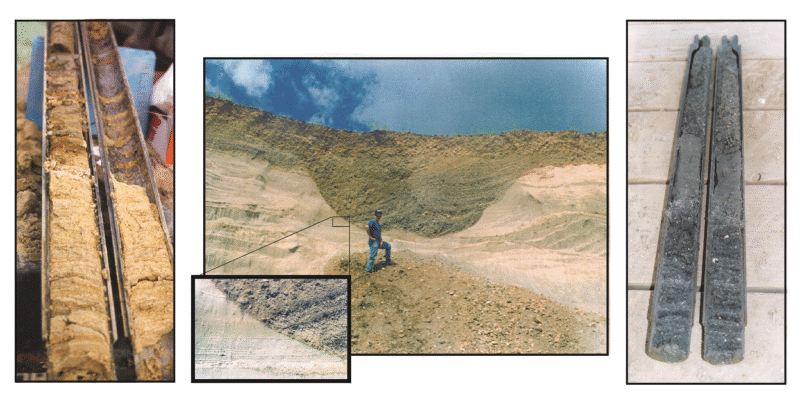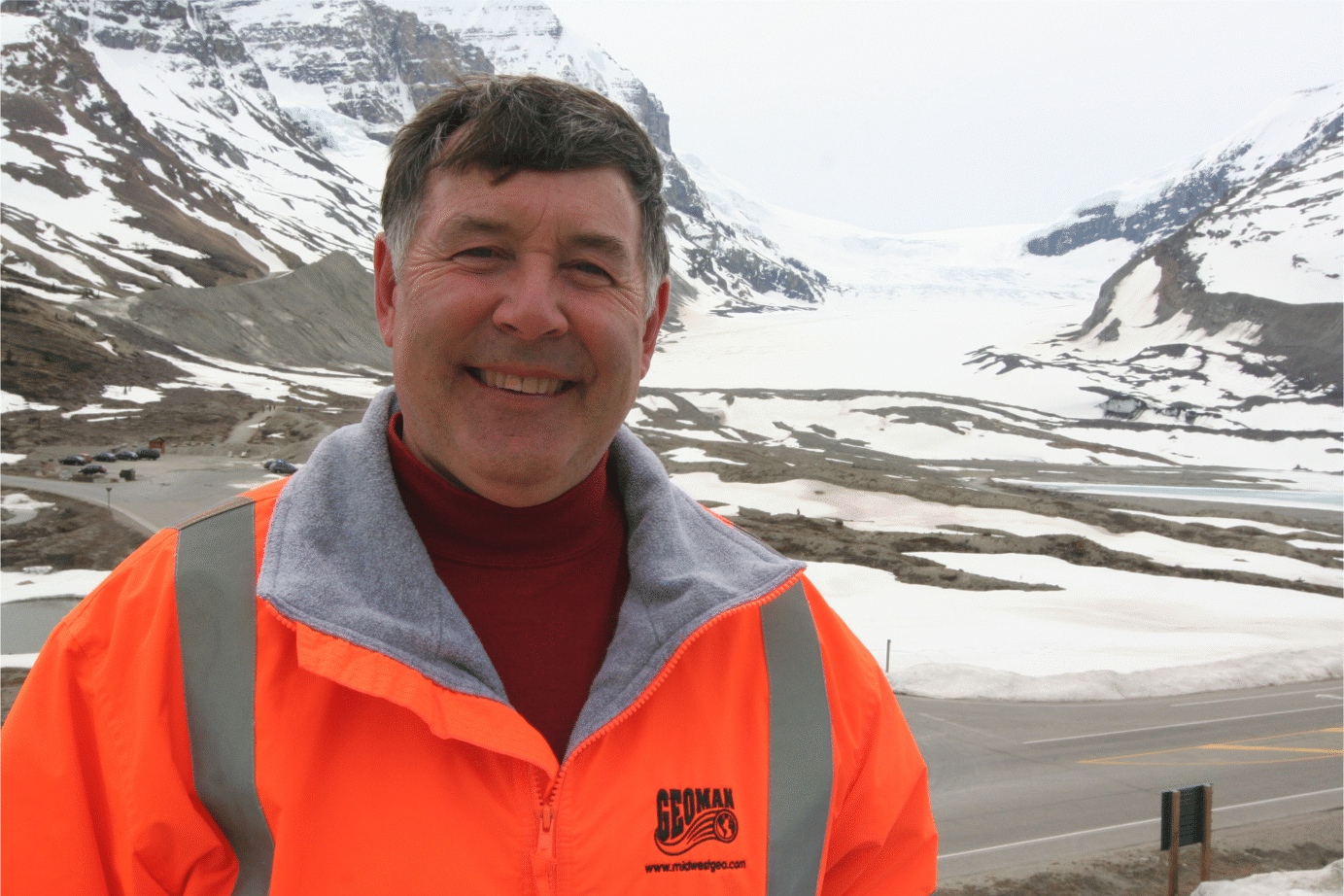Hydrogeologic Application of
Glacial Depositional Environments:
Part 2, Glaciofluvial and Glaciolacustrine
For ground water movement in water-lain sediments such as (Glacio)fluvial and (Glacio)lacustrine deposits, one important question is the degree of variability and heterogeneity of the sediment sequence. Some simple key indictors can lend insight in the field to unraveling the complexities and scale of deposition of water-lain sediments.
Equally daunting is when contaminants occur in highly variable fluvial or lacustrine sediments. Although High-Resolution Site Characterization tools have unique mapping advantages, there is no substitute for applying geologic context to glaciofluvial and glaciolacustrine deposits.
And finally, sedimentary variability of glaciofluvial and glaciolacustrine sediments can be seemingly impossible to predict in the field due to the thin nature of some bedding structures. However there are clues to be watching for in the field that lend information about marker beds for correlation from boring to boring that help take gigantic steps in unraveling facies correlation.
Related questions include:
- What to glaciofluvial and glaciolacustrine sediments look like?
- How does sedimentary structure identify each type of deposit?
- How does scale of deposition relate to the Conceptual Site Model?
- What strategies exist for concisely describing water-lain sediments on boring logs?
- Where should well screens be set to ensure they are monitoring the same unit?
- When do I lump or split soil classifications into facies models for water-lain glacial deposits?
- What are the strategies for depicting sorted sediments in Conceptual Site Models?

Geotechnical engineers face questions no less challenging. Soil suitability, it's range in properties, and heterogeneities / uniformities are each controlled by depositional processes. Predicting the nature of sediment from understanding deposition has proven much more reliable than hoping to find trends in N-values, excessive soils lab data, or even hoping to "match" soil classification between borings.
Related questions include:
- What clues help predict variability or uniformity of the subsurface?
- What is range in permeabilities beneath a site?
- What are the limitations of using soil classifications, soils lab data, or N-values for understanding the subsurface?
- How to I apply geologic content for unraveling hydrogeologic complexities?
- How do I successfully sample the sequence to maximize technical efficiency?
What does taking the mystery out of such complex subsurface conditions require? An understanding of glacial stratigraphy, glacial depositional environments, and the magnitude of any post-depositional weathering alteration.

This webinar, Part 2, provides techniques for identifying and understanding glacial depositional environments of water-lain fluvial and lacustrine deposits. Discover the processes of deposition that form ice-marginal and proglacial sediments and the implications for these sediments during hydrogeologic, environmental, and geotechnical projects.
See what others are saying...
"The (9-hour Hydrogeology of Glacial Deposits) online course offers a whole new way of understanding and evaluating till deposits, based on their depositional environments. It's refreshing to see the recent progress in this field."
- Lance Kazzi, LEP, Principal Geologist, Arcadis U.S., Inc.
"The webinar series Is fantastic, thank you. Glacial geology is a big part of our work here on Long Island, so the series was very much in line with our work."
- Michael Como, U.S. Geological Survey
Instructors Bio
Tim Kemmis, PhD, PG
 Tim Kemmis, PhD, PG is a Senior Hydrogeology Consultant and Project Manager for large-scale hydrogeologic investigations. His unique experience as both an applied researcher and consultant has enabled Tim to effectively teach staff at all levels how unravel sedimentary complexities by making fundamentally sound observations, preparing complete and accurate boring logs and confidently correlating geologic units.
Tim Kemmis, PhD, PG is a Senior Hydrogeology Consultant and Project Manager for large-scale hydrogeologic investigations. His unique experience as both an applied researcher and consultant has enabled Tim to effectively teach staff at all levels how unravel sedimentary complexities by making fundamentally sound observations, preparing complete and accurate boring logs and confidently correlating geologic units.
Tim received his bachelor's degree in agricultural soil science from the University of Illinois and his master's degree in glacial geology while working as a graduate assistant at the Illinois State Geological Survey.
He worked 14 years for the Iowa Geological Survey, during which he received his Ph.D., and where he:
- Carried out glacial sedimentologic investigations
- Remapped the Des Moines Glacial lobe
- Established the formal glacial stratigraphy for the lobe based on depositional environments
- Discovered a new type of hummocky glacial topography
- Determined the geometry and origin of jointing in glacial tills
- Developed a lithofacies code to decipher the history of glacial outwash and alluvial sequences
Tim is a co-founder of Midwest GeoSciences Group and has successfully taught many courses and webinars dedicated to improving boring logs and helping geologists think on their feet.
| Fee: |
249.00 USD Per Webinar
|
| |
You're SAVING $50 USD just for being a Member
|
| Materials and Downloads: |
Session Slides (PDF)
Additional MaterialsRecord of Attendance Form (PDF)
|
Number of
Participants: |
AS OF JUNE 1, 2020, WEBINARS ARE PRICED FOR INDIVIDUALS WORKING ALONE. Pricing is discounted for individual registrations for people working alone.
|
Continuing
Education
Certificates: |
$14.95 each. Official CEU certificates are available as an option. After successful completion of this webinar, a link will be provided to order a certificate.
|
| Access: |
On-demand, anytime 24/7. |
| Discounts: |
Buy 3 on-demand webinars, and get 3 on-demand webinars for free!
|
| Duration: |
120 minutes |
| PDH Earned: |
2.0 hours |
| MA LSP: |
2.0 hours (MA LSP No. 1709) |
| CT LEP: |
2.0 hours (part of CT LEP-491E) |
| |
|
| Instructor(s): |
Tim Kemmis, PhD, PG |